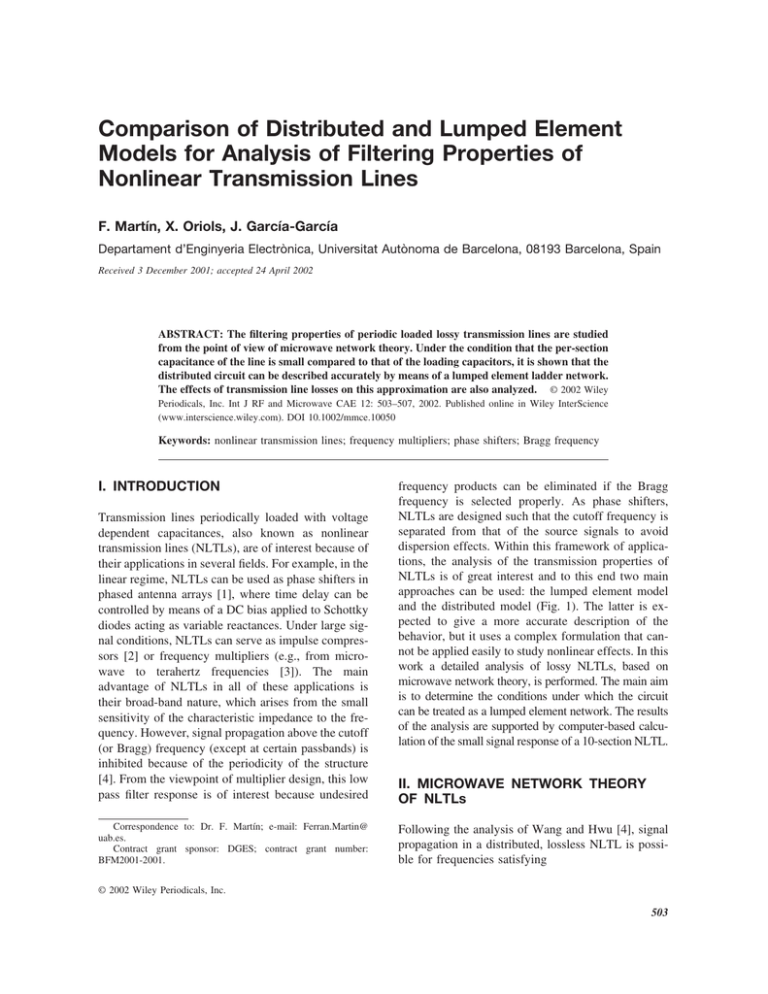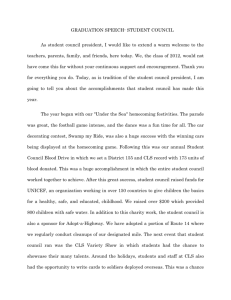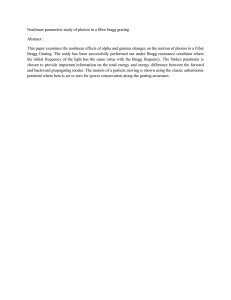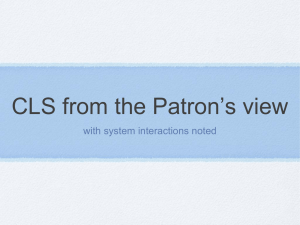Comparison of distributed and lumped element models for analysis
advertisement

Comparison of Distributed and Lumped Element Models for Analysis of Filtering Properties of Nonlinear Transmission Lines F. Martı́n, X. Oriols, J. Garcı́a-Garcı́a Departament d’Enginyeria Electrònica, Universitat Autònoma de Barcelona, 08193 Barcelona, Spain Received 3 December 2001; accepted 24 April 2002 ABSTRACT: The filtering properties of periodic loaded lossy transmission lines are studied from the point of view of microwave network theory. Under the condition that the per-section capacitance of the line is small compared to that of the loading capacitors, it is shown that the distributed circuit can be described accurately by means of a lumped element ladder network. The effects of transmission line losses on this approximation are also analyzed. © 2002 Wiley Periodicals, Inc. Int J RF and Microwave CAE 12: 503–507, 2002. Published online in Wiley InterScience (www.interscience.wiley.com). DOI 10.1002/mmce.10050 Keywords: nonlinear transmission lines; frequency multipliers; phase shifters; Bragg frequency I. INTRODUCTION frequency products can be eliminated if the Bragg frequency is selected properly. As phase shifters, NLTLs are designed such that the cutoff frequency is separated from that of the source signals to avoid dispersion effects. Within this framework of applications, the analysis of the transmission properties of NLTLs is of great interest and to this end two main approaches can be used: the lumped element model and the distributed model (Fig. 1). The latter is expected to give a more accurate description of the behavior, but it uses a complex formulation that cannot be applied easily to study nonlinear effects. In this work a detailed analysis of lossy NLTLs, based on microwave network theory, is performed. The main aim is to determine the conditions under which the circuit can be treated as a lumped element network. The results of the analysis are supported by computer-based calculation of the small signal response of a 10-section NLTL. Transmission lines periodically loaded with voltage dependent capacitances, also known as nonlinear transmission lines (NLTLs), are of interest because of their applications in several fields. For example, in the linear regime, NLTLs can be used as phase shifters in phased antenna arrays [1], where time delay can be controlled by means of a DC bias applied to Schottky diodes acting as variable reactances. Under large signal conditions, NLTLs can serve as impulse compressors [2] or frequency multipliers (e.g., from microwave to terahertz frequencies [3]). The main advantage of NLTLs in all of these applications is their broad-band nature, which arises from the small sensitivity of the characteristic impedance to the frequency. However, signal propagation above the cutoff (or Bragg) frequency (except at certain passbands) is inhibited because of the periodicity of the structure [4]. From the viewpoint of multiplier design, this low pass filter response is of interest because undesired II. MICROWAVE NETWORK THEORY OF NLTLs Correspondence to: Dr. F. Martı́n; e-mail: Ferran.Martin@ uab.es. Contract grant sponsor: DGES; contract grant number: BFM2001-2001. Following the analysis of Wang and Hwu [4], signal propagation in a distributed, lossless NLTL is possible for frequencies satisfying © 2002 Wiley Periodicals, Inc. 503 504 Martı́n, Oriols, and Garcı́a-Garcı́a Figure 1. The elementary section of the NLTL according to the (a) distributed and (b) lumped element model. CD(V) is the capacitance of the nonlinear devices. In (b) each transmission line section between nonlinear reactances is modeled by a series inductance (L) and shunt capacitance (C0). The variables R and G account for the transmission line losses. C lsZ0 ⬍ 2 cot , (1) where Cls is the linearized capacitance of the loading devices for small signal operation or the large signal capacitance [defined as the average value of CD(V) over the voltage excursion of the feeding signal] in the nonlinear regime; Z0 ⫽ (L/C0)1/2 is the characteristic impedance of the unloaded line; and ⫽ [(LC0)1/2]/2 is half the electrical length between nonlinear reactances, where L and C0 are the per-section inductance and capacitance, respectively. Expression (1) determines the passbands of the structure and implicitly gives the Bragg frequency as the cutoff point of the first passband. In the lumped element model the Bragg frequency is given by Ble ⫽ 2 冑L共C0 ⫹ Cls兲 . (2) Let us now analyze the influence of Cls on the Bragg frequency for the two models. In the distributed model, for large values of Cls, the electrical length between the nodes becomes very short and the Bragg frequency can be approximated by Bd ⫽ 2 冑LCls , (3) which coincides with the Bragg frequency given by the lumped element model under the condition that Cls Ⰷ C0. For small values of Cls (Cls Ⰶ C0), both members of eq. (1) are very small at the Bragg frequency, and the following approximation can be applied: Bd ⫽ 冑LC0 , (4) where the condition that (B) ⬇ /2 has been implicitly assumed. In this case, the Bragg frequency differs from that given by the lumped element model by a factor of /2. In Figure 2 the variation of the cutoff frequency with the Cls shows that for values significantly larger than C0, the lumped element and distributed models give similar results. To further examine the validity of the lumped element model, we obtained the T-network equivalent circuit of the elementary section of the NLTL, including the effects of transmission line losses. To this end, we first obtained the transmission matrix (A) and hence the impedance matrix using standard transforms. The series Zs and shunt Zp impedances of the T-network are then given by Zs ⫽ 2 sinh2 ⫹ jClsZ0 sinh cosh , sinh 2/Z0 ⫹ jClscosh2 (5a) Analysis of Filtering Properties of NLTLs 505 Figure 2. A comparison of the Bragg frequency obtained by means of the two models as a function of Cls; L ⫽ 0.108 nH and C0 ⫽ 43.5 fF. Zp ⫽ 1 . sinh 2/Z0 ⫹ jClscosh2 (5b) Due to losses, and Z0 are now given by (1/2)[(R ⫹ jL)(G ⫹ jC0)]1/2 and [(R ⫹ jL)/(G ⫹ jC0)]1/2, respectively. If Cls is larger than C0 (the per-section capacitance of the line), then for the frequencies of interest (i.e., below the Bragg frequency) is small and (5) can be approximated by Zs ⬇ Zp ⬇ 共2 ⫹ j C lsZ0 兲 R L ⬇ ⫹ j , 2 2 2 ⫹ jCls Z0 1 2 ⫹ j C ls Z0 ⬇ 1 . G ⫹ j共C0 ⫹ Cls兲 (6a) (6b) According to these results, under the condition Cls Ⰷ C0, the distributed model can be approximated by the lumped element network. We also assumed that transmission line losses are small enough such that RC Ⰶ 1 and GL Ⰶ 1, otherwise the Taylor series approximation used to obtain eq. (6) is not possible. These conditions lead us to R Ⰶ Z0l(Cls/C0)1/2 and G Ⰶ Z0l⫺1(Cls/C0)1/2, where Z0l is the impedance of the lossless unloaded line [Z0l ⫽ (L/C0)1/2]. The latter inequalities are easily satisfied if Cls is larger than C0, even if the losses are not negligible. (In actual structures the skin effect losses can lead to high values of R at high frequencies.) It is therefore clear that the lumped element network is a good approximation to the behavior of periodic loaded lossy transmission lines under the assumption that Cls/C0 Ⰷ 1. If this condition is not satisfied, the lumped element network is only valid at moderate and low frequencies (compared to the Bragg frequency), and the differences between the lumped element and distributed models are sensitive to transmission line losses. III. SIMULATION RESULTS To support the previous comments, we obtained the small signal response of a 10-section transmission line (lumped element and distributed model) by means of computer simulation. For this we developed our own code, because it allows us to express the electrical parameters of the distributed model (Z0 and ) in terms of the parameters of the lumped model (L, C0, R, and G) and frequency. In this way a realistic comparison between both models can be done. To obtain the small signal response, the transmission (A) matrix is first calculated from the contribution of each individual section, and then the scattering parameter S21 is inferred from standard transformation. Two situations were considered: Cls Ⰷ C0 [Fig. 3(a)] and Cls comparable to C0 [Fig. 3(b)]. In order to analyze the effect of losses, different values of R were considered. (G is assumed to be negligible in both cases.) As can be seen in Figure 3(a), the distributed and lumped element models give similar results up to the Bragg frequency (⬇12 GHz); apart from a degradation of the transmission characteristic, losses do not affect this agreement. In Figure 3(b) it can be seen 506 Martı́n, Oriols, and Garcı́a-Garcı́a ther limit the validity of the lumped element network to analyze NLTL performance. IV. CONCLUSION We showed that there is good agreement between the lumped element and distributed models of NLTLs when the values of the nonlinear loading capacitors are greater than the per-section capacitance of the line. When Cls ⬇ C0, good agreement only occurs well below the Bragg frequency and depends on the losses. In practice, it is desirable for Cls to be the dominant capacitance, and the losses are low. Therefore, the lumped element analysis can be used to design NLTL delay lines and frequency multipliers. ACKNOWLEDGMENT The authors are grateful to DGES for the support of this work. Thanks also to Dr. R.E. Miles (University of Leeds) for his suggestions. REFERENCES Figure 3. A comparison of the linear response (|S21|2) of a 10-section NLTL obtained by means of the (—) distributed and (- - -) lumped element models. (a) L ⫽ 1.25 nH, G ⫽ 0 S, Cls ⫽ 0.5 pF, and C0 ⫽ 0.043 pF; and (b) C0 ⫽ 0.5 pF. that the lumped element model underestimates the cutoff frequency and provides a reasonable approximation to the distributed model response at low frequencies only. As R increases, the divergence of responses between the two models begins at lower frequencies. Therefore, transmission line losses fur- 1. W.M. Zhang, R.P. Hsia, C. Liang, G. Song, C.W. Domier, and N.C. Luhman, Jr., Novel low-loss delay line for broadband phased antenna array applications, IEEE Microwave Guided Wave Lett 6 (1996), 182–184. 2. M. Case, M. Kamegawa, R. Yu, and M.J.W. Rodwell, Impulse compression using soliton effects in a monolithic GaAs circuit, Appl Phys Lett 58 (1991), 173–175. 3. E. Lheurette, M. Fernández, X. Melique, P. Mounaix, O. Vanbésien, and D. Lippens, Non linear transmission line quintupler loaded by heterostructure barrier varactors, Proc 29th European Microwave Conf, Microwave Engineering Europe, Munich, 1999, 217–220. 4. X. Wang and R.J. Hwu, Theoretical analysis and FDTD simulation of GaAs nonlinear transmission lines, IEEE Trans Microwave Theory Tech 47 (1999), 1083–1091. Analysis of Filtering Properties of NLTLs 507 BIOGRAPHIES Ferran Martı́n was born in Barakaldo (Vizcaya), Spain in 1965. He received the B.S. degree in physics from the Universitat Autònoma de Barcelona in 1988 and the Ph.D. degree in 1992. Since 1994 he has been an Associate Professor of Electronics in the Departament d’Enginyeria Electrònica (Universitat Autònoma de Barcelona). His current research interests include modeling and simulation of electron devices for high frequency applications, millimeter wave and terahertz generation systems, and the application of electromagnetic bandgaps to microwave and millimeter wave circuits. Joan J. Garcia was born in Barcelona in 1971. He received the B.S. degree in physics in 1994 and the Ph.D. degree in electrical engineering in 2001, both from the Universitat Autònoma de Barcelona. Afterward he became a Postdoctoral Research Fellow at the Institute of Microwaves and Photonics of Leeds University in the INTERACT European project. Dr. Garcia is currently working at the Universitat Autònoma de Barcelona as a Postdoctoral Research Fellow in the Ramon y Cajal project of the Spanish government. Xavier Oriols received his B.S. and M.S. degrees in physics and Ph.D. in electronic engineering from the Autonomous University of Barcelona in 1993, 1994, and 1999, respectively. During 1997 he worked on the simulation of dynamic properties of GaAs resonant tunneling diodes at the Institute of Electronic and Microelectronic du Nord (France). In 2001 he was a Visiting Professor in the Physics Department of the State University of New York, working on dual-gate nanometric metal oxide semiconductor field effect transistors. He is currently an Associate Professor in the Electronic Engineering Department, Autonomous University of Barcelona. Dr. Oriols’ present interests include the study of noise and high frequency properties of nanometric devices.





